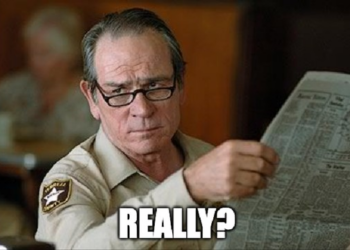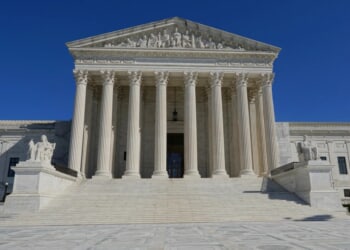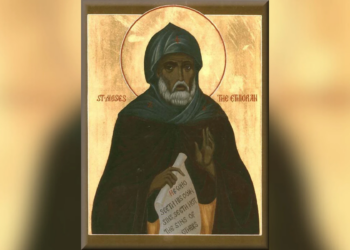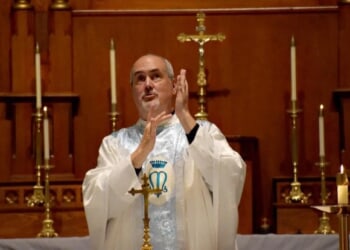Many years ago, during a late-night walk through Oxford’s beautiful Botanical Gardens, two men discussed whether the life and death of Christ was a fairy story. Both men agreed that indeed it was: one man, an atheist literature professor, averred that the life and death of Christ was no more than a fairy story, but the other, a Catholic philologist, argued that it was the one true fairy story, of which all other fairy stories were but pale shadows. The latter argument, proffered by J.R.R. Tolkien, won the day, and C.S. Lewis converted to Christianity.
“The Birth of Christ is the Eucatastrophe of Man’s history.”
A key element of Tolkien’s thought on Christ’s life and death as fairy story was detailed in his lecture and essay, “On Fairy Stories.” First of all, the Professor carefully clarifies that a “fairy story,” properly understood, is not a story about fairies, the diminutive, winged, sprite-like figures so often pictured in children’s books and the like. Instead, a “fairy story” is one which takes place in the world of Faerie, a mythical, mystical land of magic. Norse mythology had Valhalla, the Greek gods had Olympus, Arthur had Camelot, and the list goes on. These are mere imaginings, for the most part, but they do reflect reality: Valhalla is a pagan shadow of Heaven, Olympus yearns to be the court of the archangels, and Camelot bears a striking resemblance to the Church.
The master-stroke of Tolkien’s argument, though, is what he calls “eucatastrophe” or “the good catastrophe, the sudden joyous ‘turn.’” The Professor clarifies that eucatastrophe is not “escapist” or what in narrative terms might be seen as a deus ex machina device, but is “a sudden and miraculous grace: never to be counted on to recur.” He continues:
It does not deny the existence of dyscatastrophe, of sorrow and failure: the possibility of these is necessary to the joy of deliverance; it denies (in the face of much evidence, if you will) universal final defeat and in so far is evangelium, giving a fleeting glimpse of Joy, Joy beyond the walls of the world, poignant as grief.
The Meaning of Eucatastrophe
For Tolkien, the true “mark” of a fairy story is eucatastrophe. But eucatastrophe in fairy stories, he is careful to point out, is not singularly unique to fairy stories, nor is it a mere fantastical invention of the literary genre. Rather, just as fairy stories, myths, and fantasy tales all echo, mirror, derive from, and partake in reality, so also eucatastrophe in fairy stories is but an echoing, mirroring, deriving from, or partaking in a far grander, higher, and nobler reality. Eucatastrophe in fairy stories can “be explained as a sudden glimpse of the underlying reality or truth. It is not only a ‘consolation’ for the sorrow of this world, but a satisfaction, and an answer to that question, ‘Is it true?’” Here, then, is the crux of Tolkien’s argument:
The Gospels contain a fairy-story, or a story of a larger kind which embraces all the essence of fairy-stories. They contain many marvels — peculiarly artistic, beautiful, and moving: ‘mythical’ in their perfect, self-contained significance; and among the marvels is the greatest and most complete conceivable Eucatastrophe. But this story has entered History and the primary world; the desire and aspiration of sub-creation has been raised to the fulfillment of Creation. The Birth of Christ is the Eucatastrophe of Man’s history. The Resurrection is the Eucatastrophe of the story of the Incarnation. This story begins and ends in joy.… There is no tale ever told that men would rather find was true, and none which so many skeptical men have accepted as true on its own merits.
The Professor suggests that one would feel great joy to find that one’s favorite fairy story or fantasy story were true. Consider the countless children who take such pleasure in stories of Good St. Nick, the many who check the backs of wardrobes to see if there is a Narnia in there, and the arduous few who dig in the backyard for a pirate’s buried treasure of the ruins of Camelot or Atlantis.
The joy one would experience upon discovering that a fairy story is true would be the same kind of joy elicited, Tolkien posits, by that story’s eucatastrophe. He adds, however, “The Christian joy, the Gloria, is of the same kind; but it is preeminently (infinitely, if our capacity were not finite) high and joyous. But this story is supreme; and it is true. Art has been verified.… Legend and History have met and fused.”
Christians everywhere celebrate today Easter, commemorating, honoring, rejoicing in, and glorying in the triumphant resurrection of Christ from the dead. For 2,000 years, Christians have gathered together every year to repeat and read the Gospel accounts of this supreme eucatastrophe: not only did God become man and Love become flesh, not only did He die a gruesome death to repay a debt that we never could, but He also conquered death itself and flung wide the gates of Heaven. Through our sin and the sin of our first parents, we lost the paradise that God had made for us on earth. What a “good catastrophe” or “sudden joyous turn” it is, then, to discover that He prepared an even greater Paradise for us in Heaven.
It is not the mere sense of or appreciation for eucatastrophe that has led Christians to celebrate Christ’s resurrection year after year for two millennia, as one would read and re-read a particularly good or beautiful book and smile every time at the “sudden joyous turn.” As beautiful as Tolkien’s work is, no man ever gave his life because he believed Aragorn or Gandalf to be real. No martyrs have been inspired by the work of Andrew Lang, George Macdonald, or Lewis. Rather, the reason that Christians proclaim, even in the face of death, over the course of centuries, Christ’s resurrection is because it is the eucatastrophe that is real, it is the one true fairy story.
READ MORE from S.A. McCarthy:
Poland Sees Surge in Anti-Catholic Sentiment


![NYC Tourist Helicopter Falls into Hudson River, Siemens Executive and Family Among Those Killed [WATCH]](https://www.right2024.com/wp-content/uploads/2025/04/NYC-Tourist-Helicopter-Falls-into-Hudson-River-Siemens-Executive-and-350x250.jpg)






![Green Day’s Cringe Trump Diss Ends in Fire and Evacuation [WATCH]](https://www.right2024.com/wp-content/uploads/2025/04/Green-Days-Cringe-Trump-Diss-Ends-in-Fire-and-Evacuation-350x250.jpg)
![Red Sox Fan Makes the ‘Catch of the Day’ with Unconventional ‘Glove’ [WATCH]](https://www.right2024.com/wp-content/uploads/2025/04/Red-Sox-Fan-Makes-the-‘Catch-of-the-Day-with-350x250.jpg)
![Bikini Clad Spring Breakers Prove Our Education System is Failing Students [WATCH]](https://www.right2024.com/wp-content/uploads/2025/03/Bikini-Clad-Spring-Breakers-Prove-Our-Education-System-is-Failing-350x250.jpg)




